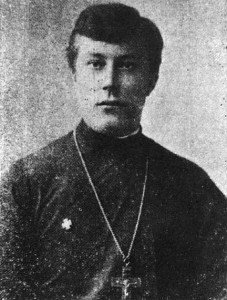As you may have heard, a few weeks ago thieves made off with six church bells from Holy Dormition Church (OCA) in Cumberland, Rhode Island. The bells were soon recovered, albeit in a seriously damaged condition. The whole episode got me thinking about other instances in American history in which valuable church bells were stolen from Orthodox parishes.
One of those thievings took place exactly 108 years ago yesterday morning, May 5, 1902. The victimized parish was St. Vladimir’s Russian Church in Chicago, which would soon become Holy Trinity Cathedral. Its priest, Fr. John Kochurov, went on to become one of the first hieromartyrs killed by the Bolsheviks.
The bell of St. Vladimir’s was originally part of the Russian exhibit at the Chicago World’s Fair of 1893. It was your classic bronze Russian bell, cast in St. Petersburg, and covered with bas-relief icons of saints. At the conclusion of the World’s Fair, the iconostasis of the Russian exhibit was given to a new parish in Streator, Illinois, and the 520-pound bell was donated to Chicago’s fledgling Russian church. According to the Chicago Tribune (5/6/1902), “The gift was received with enthusiasm, which was turned to grief when it was found that the building was too small to allow the bell to be placed in position.”
So, for nearly a decade, the 4-foot tall, 3 1/2-foot wide bell sat in storage, in a building attached to the small Russian church. By 1902, construction on the new Holy Trinity Cathedral was under way, and a special belfry was designed for the great bell. Installation was scheduled for August, but on the morning of May 5, three men broke into the storage area, rolled the bell into an alley, hoisted it onto a wagon, and drove away.
As you might imagine, the parishioners of St. Vladimir’s were terribly upset. The Tribune reported, “The chapel was filled yesterday with angry and gesticulating members of the church, who left the place to search the city for a trace of the bell.”
They had no luck, but the next day, May 6, Fr. John Kochurov visited the city’s Greek parish. While the two churches were made up of different ethnic groups and answered to different ecclesiastical authorities, they had long maintained friendly relations with one another. On this occasion, the Greek priest offered the pulpit to Kochurov. According to the Tribune, “A general meeting there of both congregations, comprising seven-tenths of the members of the faith in the city, will be addressed by him and exhorted to recover the bell and cause the arrest of the thieves.”
In the Tribune article on May 6, we’re told that at least one of the thieves was a member of St. Vladimir’s Church, although they don’t seem to know his name. The police thought that the thieves planned to melt down the bell and sell the metal. The bell was valued at $500 — over $12,000 in today’s money. But, said the Tribune, “members of the congregation assert that it is the work of persons who have declared their enmity to the pastor and his flock.”
Alas, I haven’t been able to track down the rest of this story. If anyone knows what became of the bell, please send me an email at mfnamee [at] gmail [dot] com.
[This article was written by Matthew Namee.]

…other instances in American history in which valuable church bells were stolen…
Well, I guess they were bought, officially, in 1930 by American philanthropist Charles R. Cranebut, the Orthodox had always viewed the 18 “Harvard bells” at Lowell House as having been stolen from the Danilov monastery in Russia.
There is an interesting article in The New Yorker about the bells, their repatriation to Russia, and Konstantin Saradzhev, “Moscow’s most famous bell ringer” who was the perhaps mad genius originally tasked with installing the bells at Lowell House:
Elif Batuman, Onward and Upward with the Arts, “The Bells,” The New Yorker, April 27, 2009, p. 22.
http://www.newyorker.com/reporting/2009/04/27/090427fa_fact_batuman
Fr. Milovan Katanic wrote about this article here:
http://frmilovan.wordpress.com/2009/04/29/russian-bells-and-the-future-of-music/